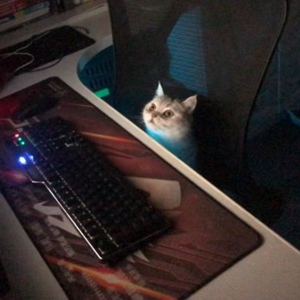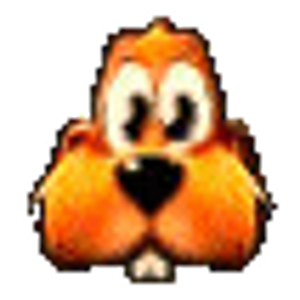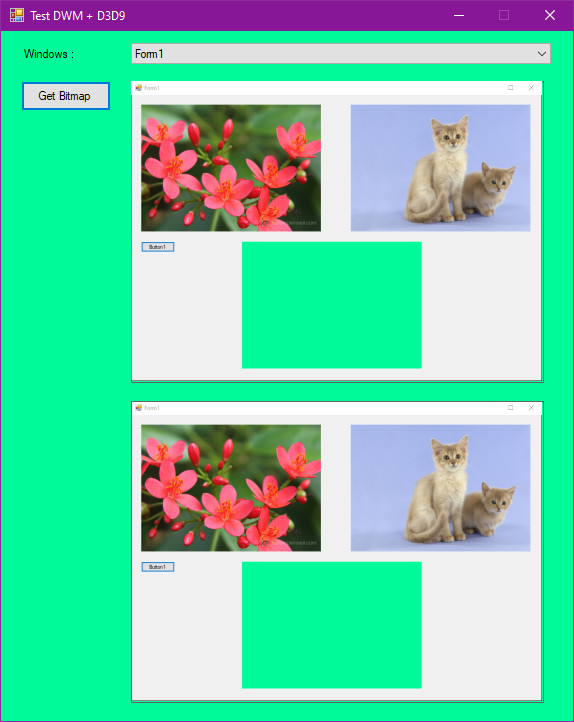@Junjie Zhu - MSFT In the saved image its missing the window titlebar, also how i could capture the window when its covered by another?
int CaptureAnImage(HWND hWnd)
{
HDC hdcScreen;
HDC hdcWindow;
HDC hdcMemDC = NULL;
HBITMAP hbmScreen = NULL;
BITMAP bmpScreen;
DWORD dwBytesWritten = 0;
DWORD dwSizeofDIB = 0;
HANDLE hFile = NULL;
char* lpbitmap = NULL;
HANDLE hDIB = NULL;
DWORD dwBmpSize = 0;
// Retrieve the handle to a display device context for the client
// area of the window.
hdcScreen = GetDC(hWnd); // GetDC(NULL);
hdcWindow = GetDC(hWnd);
// Create a compatible DC, which is used in a BitBlt from the window DC.
hdcMemDC = CreateCompatibleDC(hdcWindow);
if (!hdcMemDC)
{
MessageBox(hWnd, L"CreateCompatibleDC has failed", L"Failed", MB_OK);
goto done;
}
// Get the client area for size calculation.
RECT rcClient;
GetClientRect(hWnd, &rcClient);
// This is the best stretch mode.
SetStretchBltMode(hdcWindow, HALFTONE);
// The source DC is the entire screen, and the destination DC is the current window (HWND).
if (!StretchBlt(hdcWindow,
0, 0,
rcClient.right, rcClient.bottom,
hdcScreen,
0, 0,
rcClient.right, //GetSystemMetrics(SM_CXSCREEN),
rcClient.bottom, //GetSystemMetrics(SM_CYSCREEN),
SRCCOPY | CAPTUREBLT))
{
MessageBox(hWnd, L"StretchBlt has failed", L"Failed", MB_OK);
goto done;
}
// Create a compatible bitmap from the Window DC.
hbmScreen = CreateCompatibleBitmap(hdcWindow, rcClient.right - rcClient.left, rcClient.bottom - rcClient.top);
if (!hbmScreen)
{
MessageBox(hWnd, L"CreateCompatibleBitmap Failed", L"Failed", MB_OK);
goto done;
}
// Select the compatible bitmap into the compatible memory DC.
SelectObject(hdcMemDC, hbmScreen);
// Bit block transfer into our compatible memory DC.
if (!BitBlt(hdcMemDC,
0, 0,
rcClient.right - rcClient.left, rcClient.bottom - rcClient.top,
hdcWindow,
0, 0,
SRCCOPY | CAPTUREBLT))
{
MessageBox(hWnd, L"BitBlt has failed", L"Failed", MB_OK);
goto done;
}
// Get the BITMAP from the HBITMAP.
GetObject(hbmScreen, sizeof(BITMAP), &bmpScreen);
BITMAPFILEHEADER bmfHeader;
BITMAPINFOHEADER bi;
bi.biSize = sizeof(BITMAPINFOHEADER);
bi.biWidth = bmpScreen.bmWidth;
bi.biHeight = bmpScreen.bmHeight;
bi.biPlanes = 1;
bi.biBitCount = 32;
bi.biCompression = BI_RGB;
bi.biSizeImage = 0;
bi.biXPelsPerMeter = 0;
bi.biYPelsPerMeter = 0;
bi.biClrUsed = 0;
bi.biClrImportant = 0;
dwBmpSize = ((bmpScreen.bmWidth * bi.biBitCount + 31) / 32) * 4 * bmpScreen.bmHeight;
// Starting with 32-bit Windows, GlobalAlloc and LocalAlloc are implemented as wrapper functions that
// call HeapAlloc using a handle to the process's default heap. Therefore, GlobalAlloc and LocalAlloc
// have greater overhead than HeapAlloc.
hDIB = GlobalAlloc(GHND, dwBmpSize);
lpbitmap = (char*)GlobalLock(hDIB);
// Gets the "bits" from the bitmap, and copies them into a buffer
// that's pointed to by lpbitmap.
GetDIBits(hdcWindow, hbmScreen, 0,
(UINT)bmpScreen.bmHeight,
lpbitmap,
(BITMAPINFO*)&bi, DIB_RGB_COLORS);
// A file is created, this is where we will save the screen capture.
hFile = CreateFile(L"captureqwsx.png",
GENERIC_WRITE,
0,
NULL,
CREATE_ALWAYS,
FILE_ATTRIBUTE_NORMAL, NULL);
// Add the size of the headers to the size of the bitmap to get the total file size.
dwSizeofDIB = dwBmpSize + sizeof(BITMAPFILEHEADER) + sizeof(BITMAPINFOHEADER);
// Offset to where the actual bitmap bits start.
bmfHeader.bfOffBits = (DWORD)sizeof(BITMAPFILEHEADER) + (DWORD)sizeof(BITMAPINFOHEADER);
// Size of the file.
bmfHeader.bfSize = dwSizeofDIB;
// bfType must always be BM for Bitmaps.
bmfHeader.bfType = 0x4D42; // BM.
WriteFile(hFile, (LPSTR)&bmfHeader, sizeof(BITMAPFILEHEADER), &dwBytesWritten, NULL);
WriteFile(hFile, (LPSTR)&bi, sizeof(BITMAPINFOHEADER), &dwBytesWritten, NULL);
WriteFile(hFile, (LPSTR)lpbitmap, dwBmpSize, &dwBytesWritten, NULL);
// Unlock and Free the DIB from the heap.
GlobalUnlock(hDIB);
GlobalFree(hDIB);
// Close the handle for the file that was created.
CloseHandle(hFile);
// Clean up.
done:
DeleteObject(hbmScreen);
DeleteObject(hdcMemDC);
ReleaseDC(NULL, hdcScreen);
ReleaseDC(hWnd, hdcWindow);
return 0;
}
int _tmain(int argc, _TCHAR* argv[])
{
HWND hWnd = FindWindow(NULL, L"Untitled - Notepad");
DWORD exstyle = GetWindowLong(hWnd, GWL_EXSTYLE);
SetWindowLong(hWnd, GWL_EXSTYLE, exstyle | WS_EX_LAYERED);
SetLayeredWindowAttributes(hWnd, 0, 100, LWA_ALPHA);
CaptureAnImage(hWnd);
}



